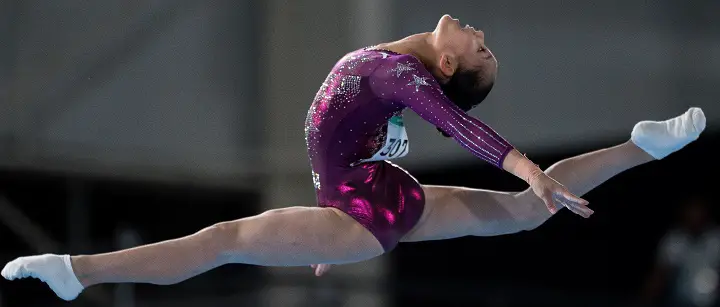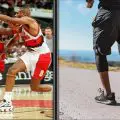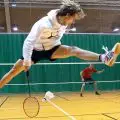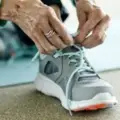*This page may contain affiliate links. When you buy through these links, we may earn a small commission at no extra cost to you.
It’s likely that if you’ve ever seen a professional gymnastics competition on TV, you’ve noticed that several Olympians have begun wearing socks throughout their performance.
Around the time of the Rio de Janeiro Olympics, there was a vast number of athletes that were choosing socked feet, while many others preferred not to wear any socks or shoes during their game.
If you are a new gymnast and you’re trying to decide what you should be wearing on your feet during practice and competition, it is important to weigh the option between getting performance gear and keeping your feet well protected.
The fact is, if you’re still relatively new at the gymnast, it could be wise for you to focus on protecting your toes and working to strengthen your feet with a thicker covering.
And this is where choosing the right footwear will play a significant role in the gymnastics game!

Do Gymnasts Wear Shoes?
Several gymnasts at the Olympics in Rio de Janeiro were seen wearing socks and shoes, and it was thought they could be receiving a slight performance advantage.
The judges had ongoing discussions about the use of shoes and socks, but since then, shoes have been seen much more widely in athletic competitions.
The basics of wearing shoes during athletic competitions like gymnastics are that you can enjoy a better grip on the apparatus.
As a gymnast, you will be able to get better turns on the floor as well as access better padding that can prevent injuries.
As there are many skills in gymnastics that can pound the feet, there are many gymnasts that are opting for the use of socks and shoes today.
For routines that involve many twists and turns as well as high-flying, having these options can add advantages for the athlete and make sure that they can practice their routine more thoroughly without injuring themselves.
Not every gymnast will wear shoes, however.
Some gymnasts will work out and perform their entire routine while they are completely barefoot.
Many gymnasts choose to go barefoot so that they can feel the mats and so that they can participate in the same way that they may have practiced.
Traditionalists in this field may shame other gymnasts for wearing socks and competition, but going up for competition without socks could have the judges focused on your feet, and it may lead to more mistakes in the routine.
Things like sweat or sticking to the mats can all lead to points off of a gymnastics routine.
Making sure that these mistakes can be avoided will mean that you can keep more points on the board and ensure that you can work at improving your experience.
Why Do Gymnasts Wear Socks?
Gymnasts are choosing to wear socks today because it’s allowing them to turn better while they are on the floor, to have extra padding, and to make sure that they can get access to a better grip on any apparatus.
Having access to socks can improve the skills of any gymnast and they aren’t considered any type of performance enhancer from the perspective of judges either.
Not every male gymnast will choose to wear socks, it ultimately comes down to the comfort level of a gymnast and the type of routine that they are going to be executing.
Many gymnasts must choose their footwear based on their routine.
This can lead to a gymnast opting for socks so that they can enjoy better twists and turns as well as an extra cushion when they are coming down in a high-flying routine.
Pros and Cons of Wearing Shoes/Socks in Gymnastics
There are many pros and cons associated with using shoes during athletic competitions.
While many gymnasts prefer the option to go barefoot without socks, many would not dream of the option of competing without some type of cushioning or safety improvement from sock feet.
If you are trying to weigh which option would be best for your needs as an amateur-level athlete, it’s important away some of the pros and cons associated with using socks and shoes and athletics.
The Pros
1- Improving safety:
No matter what type of gymnastics you do, you can add improvements to safety by choosing to wear shoes and socks.
Adding socks and shoes or even just shoes to your routine can provide you with extra cushioning.
Many types of gymnast shoes can help you feel more comfortable when you land and protect your feet with better support.
2- Improving your health:
Practicing your routine and regularly participating in competitions can put a lot of pressure on your feet.
As a gymnast’s foot can be subject to a wide degree of forces from routines that defy gravity, it’s important to protect them however you can.
Hard landings from falls and working through tough turns can all place strain on the feet and the flesh on the bottoms of the feet.
Protecting your feet, the shoe can also prevent the chance that bacteria and toe fungus could affect the overall health of an athlete.
Problems like athletes’ foot and toe fungus can lead to ongoing problems with training, downtime, and extremely sore feet.
Preventing bacteria from spreading can mean choosing a foot covering.
3- Improving performance:
Adding an extra layer of grit and making sure that the feet can feel more supported can protect them and make sure that you have a better chance at winning the competition.
Wearing shoes can help you achieve better scores.
The Cons
1- Losing feeling:
Many gymnasts prefer to feel a balance beam through the palms of their feet or participate in a floor exercise while being able to grip with their toes.
If you have been used to practicing this sensation, it can be an adjustment to switch over to shoes.
2- Being in the center of attention:
Your shoes can also stand as the center of attention. If you are wearing brightly colored shoes, this can often distract away from your routine.
What Gymnast Wear Other than Shoes and Socks?
In addition to socks and shoes (optional), there are set of right clothing that every gymnast (male and female) would wear while practicing. These are:
- Shorts
- Pants
- T-shirts
- Underwear
- Leotards or Singlets
Wearing the right clothing for gymnasts not only allows them to perform better with a full range of motion but also decreases the risk of getting an injury.
Plus, it will also help the coaches and judges to see the Olympian’s body in action.
In the end,
Practicing and training on gymnastic equipment such as the pummel horse, parallel bars, rings, and high bar needs proper skills and attention.
These can prove to be highly risky for your vulnerable body parts (like the foot and ankle).
To perform the best in your game with all the movements and maximum ease, you must keep in mind the safety of your body in the first place.
Choose to wear proper clothing (including socks and shoes) to beat the competition safely.
Incoming search terms:- can you use grip Socks in gymnastics
- what type of socks do the olympic gymnast wear
- wearing socks for gymnastics ks1






